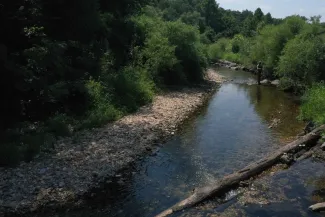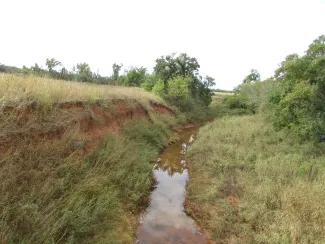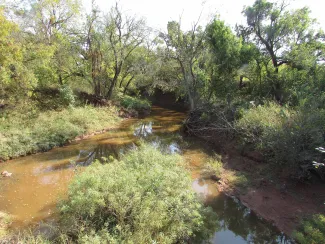Landowners with stream frontage understand the value of owning land with a creek or flowing water. The pure aesthetics of clear flowing water and the sense of serenity it brings by sitting near it is value enough for many. For others, it’s the relaxation of swimming in the cool water on a hot summer day or casting to a native smallmouth and watching it devour a perfectly placed fly. Others rely on it for meeting the needs of livestock or crops. The one connection between all these activities is water and land.

No matter what you place as value and priority for your frontage property, protecting your land from erosion should be paramount to your management goals. Erosion is arguably the biggest threat to property bordering a stream or river. It’s estimated that more than 4,400 pounds of sediment are eroded annually from every meter of stream bank. Protected banks, those that are vegetated, can erode at a rate of 8.75 yards annually while unprotected banks, those that are farmed or grazed to the edge of the stream, can erode at nearly 50 yards annually. This not only results in less property but also in damage to the stream and the aquatic community. Many think that sediment is simply ‘dirt’ but in many cases, sediment contains phosphorus. Even if the land hasn’t been farmed or fertilized for years, the “legacy phosphorus,” or excess phosphorus that plants weren’t able to use, remains in the soil for years. Unprotected banks are responsible for an estimated 3,400 pounds per year of water-soluble phosphorus. Excess phosphorus in the stream leads to algae covered rocks and degrading water quality. Both are undesirable to landowners and stream dwelling organisms.
Best management practices for agricultural and farming have never been more important. Today’s unpredictable precipitation patterns are outside normal expectations and necessitate the need for proactive conservation management practices of land and water. Installing year-round waterers instead of allowing cattle access to stream banks is an excellent first step. If that is not an option, then limiting livestock access to a single point can also be very beneficial. For landowners raising crops instead of cattle, perhaps the single greatest precautionary step you can take is protecting a buffer area of at least 125 feet along the stream bank. These steps may seem troublesome or costly but when compared to losing acres of property to erosion, they become much more economical.


Creek with eroding banks and with a vegetated buffer. (Kyle Johnson)
Interested landowners should consult the local NRCS office in their county. They often have programs to cost share conservation improvements such as year-round waterers and fencing materials used to fence out cattle as well as to establish boundaries for buffer areas.
They stopped making land along time ago. We should all strive to use our land and water wisely.